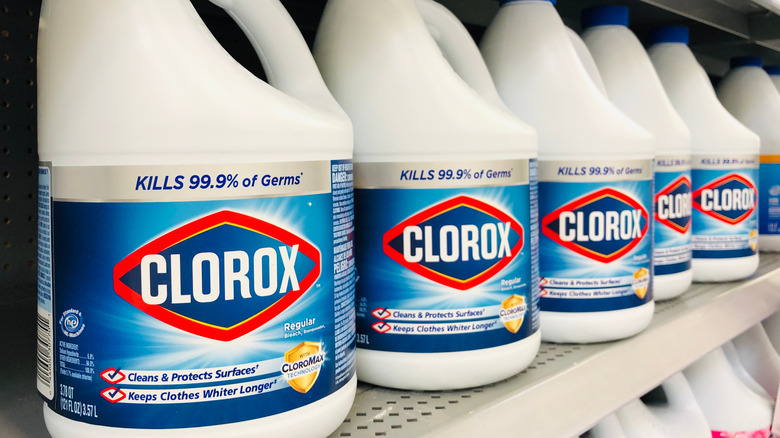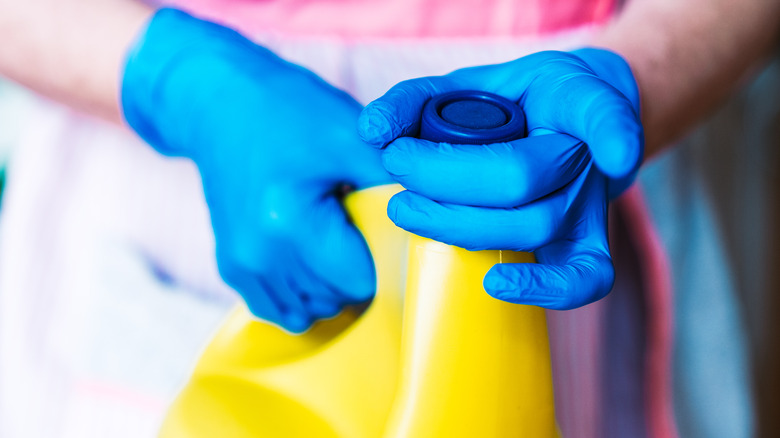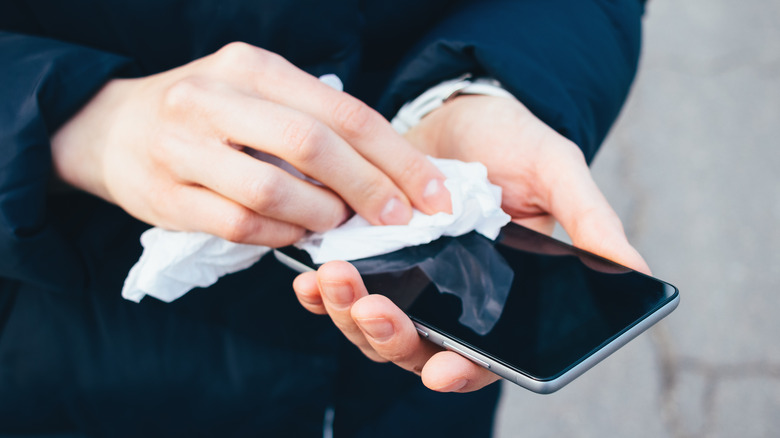Why You Should Think Twice Before Using Bleach To Clean Phone Screens
The coronavirus pandemic changed people's habits in many ways, especially when it comes to disinfecting everyday household items. So much so, that this wave of "intense cleaning" may become the norm, according to some working in the cleaning product industry. "It's not a fad where we're expecting some significant drop-off as we look to this year and beyond," Melissa Hockstad, CEO of the American Cleaning Institute (ACI), told Chemical & Engineering News. "I think the behaviors that really became part of the norm during the pandemic we'll see continuing as we look ahead."
This shift is particularly evident when it comes to how often you should really be disinfecting your phone. In January 2020, business technology news site ZDNet asked its followers on Twitter how often they disinfected their smartphones. Over 50% of the 297 users who voted said they'd never cleaned their phone, while 18.5% said they did weekly. However, when asked again in August, 40.1% of 329 users said they now cleaned their phones weekly, with 45.9% saying they didn't clean their phones.
According to the Federal Communications Commission (FCC), you should disinfect your phone screen once every day. As for what you can use to do this, you may think that products containing bleach are an option, as they are often marketed as killing most germs and bacteria. But if you use this chemical on your phone screen, you'll do more harm than good.
Bleach can irreparably damage your phone
Before you reach for the bleach, most phone manufacturers advise you not to use any cleaning product on your phone. Dr Lena Ciric, a microbiologist from University College London, demonstrated on BBC News during the pandemic (via YouTube) that soap and water are all you need to disinfect your phone screen. While you can use specific disinfectant wipes, the Federal Communications Commission (FCC) advises that you check to see if they contain chemicals like ethanol, bleach, or vinegar, as they can potentially damage the screen, which is protected by an oleophobic coating that prevents fingerprints by rejecting oil (via How-To Geek).
Cleaning your phone with a product containing bleach runs the risk of it getting into the openings like the charging port, speakers, or microphone. If this were to happen, there's a significant possibility that it could damage your phone irreparably (via iMore). So there's a reason why cleaning products by brands like Clorox and Domestos are advertised to use in cleaning kitchens and bathrooms and not your smartphone.
Soap and water can significantly reduce bacteria and germs on your phone
There are plenty of other ways to kill germs and bacteria on your phone screen that don't involve using bleach. Microbiologist Dr Lena Ciric proved on BBC News that using soap and water can significantly reduce the number of bacteria and viruses making a home for themselves on your phone (via YouTube). By measuring the microbial activity on a phone using relative light units (RLI), soap and water can reduce the number of germs to the levels expected in a surgical environment, as evidenced by Ciric.
However, Apple updated its recommendation of not using cleaning products on iPhones in March 2020 (via CNBC). Instead, Apple says "a 70 percent isopropyl alcohol wipe, 75 percent ethyl alcohol wipe, or Clorox Disinfecting Wipes" are ok to use, so long as you don't get any moisture in any of the openings (via Apple). Unlike its household cleaning products, Clorox Disinfecting Wipes are bleach-free (via Clorox).


